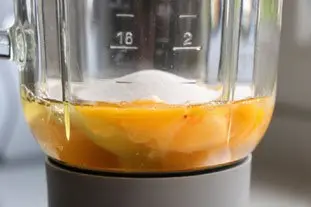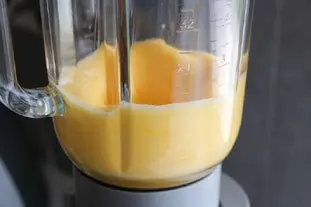The blog of cooking-ez.com
The right way to use a blender

You may well have a blender in your own kitchen. You know, that useful gadget that allows you to liquidize stuff at high speed into a smooth liquid. Of course, the most obvious use that comes to mind is for soups: if you have boiled some vegetables in water, with just a quick blast of the blender, you'll have a smooth, creamy soup.
19K 13 5
Last modified on: May 31th 2017
The right way to use a blender
At this point, we really ought to distinguish between the 2 different types of blender: "stick" and "classic".
Stick blenders (the sort professional cooks sometimes call a "giraffe") are hand-held and are designed to be plunged directly into the bowl or pan when making soup, compotes, etc. They are usually simple machines and relatively cheap. They look like this:
The other type are a little more complicated and designed to stand on a worktop. The main difference is that the food is put into the blender's own bowl or goblet (glass or plastic). Then you need to put the lid on before switching the machine on. They look something like this:
Stick blenders are fairly self-explanatory. For the second type, there's one trick it's important to know.
When blending, there is often a mix of different textures – a liquid ingredient being mixed with a more solid one – even if the end result is more or less a liquid. When making homemade pesto, for example (which, it's worth saying in passing, is far superior to what you find in the shops), you will be blending liquid olive oil and lemon juice with solid pine nuts and basil leaves.
And this is where knowing the trick comes in: you should always put the liquid into the goblet first and only then add the solid ingredients. If you do it the other way round, your ingredients may well not mix together properly, with the liquid staying on top of the blended solids. You will be obliged to stop the blender several times to poke at it and stir with a spoon, or – even worse – you might be tempted to try and intervene with the blender still running, which is highly dangerous.
To see this in practice, here's a photo taken while making a flognarde (a sort of egg custard from France's Limousin region). One stage of the recipe involves blending the eggs with a mixture of flour and sugar:
You can see how the eggs (liquid) go in first, with the flour and sugar added on top. This ensures rapid and even mixing, as you can see here:
This goes for all blenders, even the most sophisticated ones that heat and cook, such as Thermomix.
To sum up: when blending different foods, always put the liquid ingredients into the blender goblet first, before adding the solid ones.
Stick blenders (the sort professional cooks sometimes call a "giraffe") are hand-held and are designed to be plunged directly into the bowl or pan when making soup, compotes, etc. They are usually simple machines and relatively cheap. They look like this:

The other type are a little more complicated and designed to stand on a worktop. The main difference is that the food is put into the blender's own bowl or goblet (glass or plastic). Then you need to put the lid on before switching the machine on. They look something like this:

Stick blenders are fairly self-explanatory. For the second type, there's one trick it's important to know.
When blending, there is often a mix of different textures – a liquid ingredient being mixed with a more solid one – even if the end result is more or less a liquid. When making homemade pesto, for example (which, it's worth saying in passing, is far superior to what you find in the shops), you will be blending liquid olive oil and lemon juice with solid pine nuts and basil leaves.
And this is where knowing the trick comes in: you should always put the liquid into the goblet first and only then add the solid ingredients. If you do it the other way round, your ingredients may well not mix together properly, with the liquid staying on top of the blended solids. You will be obliged to stop the blender several times to poke at it and stir with a spoon, or – even worse – you might be tempted to try and intervene with the blender still running, which is highly dangerous.
To see this in practice, here's a photo taken while making a flognarde (a sort of egg custard from France's Limousin region). One stage of the recipe involves blending the eggs with a mixture of flour and sugar:

You can see how the eggs (liquid) go in first, with the flour and sugar added on top. This ensures rapid and even mixing, as you can see here:

This goes for all blenders, even the most sophisticated ones that heat and cook, such as Thermomix.
To sum up: when blending different foods, always put the liquid ingredients into the blender goblet first, before adding the solid ones.
Lasts posts
Toss the salad
When you've finished preparing a salad, green or otherwise, it's usually time to add the dressing and toss. It's often said to "toss the salad", which means to season and mix. Is it easy? Not so easy...2,0825 March 8th 2024
Half milk, half cream
In a multitude of recipes, savoury or sweet, milk is used as the main ingredient, or at least as the main liquid ingredient. Milk is used instead of water, for example, because milk contains a proportion of fat, which adds roundness and softness to the recipe. This mellowness is very pleasant on...2,100 February 27th 2024
Cutting soft cheeses
As you may have already noticed, when you have to use a "soft" cheese in a recipe - their exact name is "soft cheese" - such as Camembert, Munster or Mont d'or, it's not easy to make anything other than thick slices.2,2385 February 20th 2024
It's spinning too fast!
When you need to grate or slice vegetables, you generally use an electric machine that does all the work: a food processor, a mixer with a "slicer" extension or similar. Are these machines really suitable? Generally speaking, yes of course, but there's one criterion that often poses a problem,...5,1005 November 12th 2023
When I was a kid, I didn't like...
Maybe you've already made this strange observation: when you were a kid, there were things you hated, but as an adult it's almost the opposite? For example, you used to hate spinach or chicory, but now you love it?4,7365 November 5th 2023
Other pages you may also like
The so-called "nervous" meats
You've probably heard this before, we're talking about "nervous" meat, or meat with nerves, to describe what is indicated by the blue arrow on the left. This is a piece of beef, and what we call a nerve is not a nerve, it is in fact collagen (chemists sometimes call it a "collagen sink"), a...22K4.5 April 16th 2021
Candied fruits: don't get ripped off
Do you like candied fruit? You might like to nibble a handful or add it to a recipe, like a classic fruit cake or delicious Italian specialities like panettone or sicilian epiphany pie.53K 24.2 June 21th 2017
The 3 secrets of Parisian flan
A flan Parisien, or boulanger, is a simple yet delicious cake. A cream, a mixture of milk, eggs and sugar, is poured into a raw pastry base and baked in the oven until the pastry and cream are cooked. This is the simplest version of the recipe, probably the original one, but nowadays the cream...7,3974.7 July 21th 2023
Fruits which can ruin your jelly
There are many ways of making a fruit mousse, but one of the simplest is to prepare a fruit jelly (basically a fresh fruit coulis with gelatine) and then mix this jelly before it sets completely with whipped cream. The result is perfect for filling a charlotte, for example. But do beware;...67K4.0 March 6th 2013
What is the difference between bakery and patisserie?
This is a question that you may well have asked yourself and which I will attempt to answer. In France the two trades of "boulangerie" (bakery) and "pâtisserie" (patisserie and confectionery) have always been quite distinct, but where exactly do the boundaries lie? .119K 14.1 February 7th 2017
Follow this page
If you are interested in this page, you can "follow" it, by entering your email address here. You will then receive a notification immediately each time the page is modified or a new comment is added. Please note that you will need to confirm this following.
Note: We'll never share your e-mail address with anyone else.
Alternatively: you can subscribe to the mailing list of cooling-ez.com , you will receive a e-mail for each new recipe published on the site.









